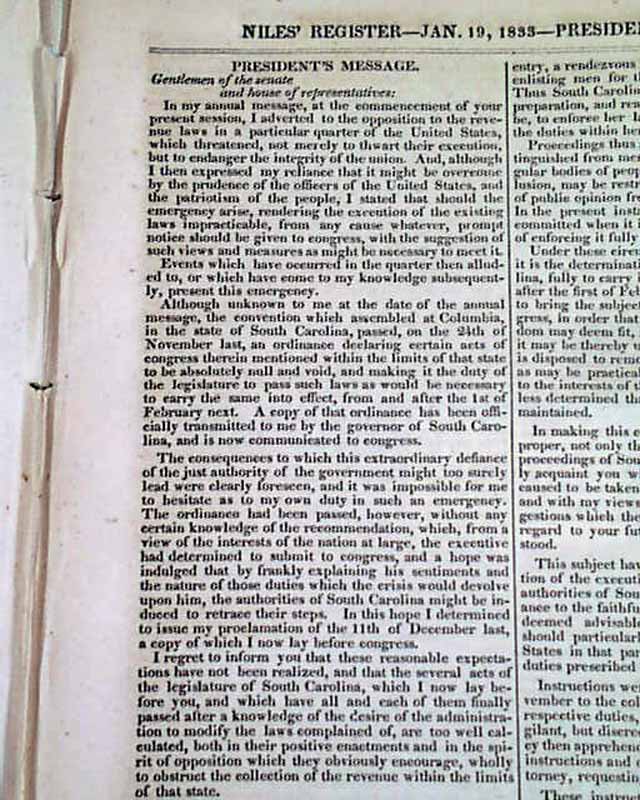Home >
The Nullification Crisis: Andrew Jackson's response...
The Nullification Crisis: Andrew Jackson's response...
Item # 705468
January 19, 1833
NILES' WEEKLY REGISTER, Baltimore, Jan. 19, 1833
* Nullification Crisis w/ Andrew Jackson
On November 26, 1832, South Carolina passed The Ordinance of Nullification which declared the Tariff of 1828 and 1832 null and void within its borders.
This issue contains President Andrew Jackson's message of January 16, 1833 in which he threatened to send in federal troops to enforce compliance, it taking 6 pages & signed at its conclusion: Andrew Jackson.
In the end a comprise was reached where South Carolina agreed to repeal the ordinance and Congress lowered the tariff. While a constitutional crisis was averted this set the stage for future conflict between the North and South, as most southerners believed decisions made at the Federal level benefited the North over the South.
The 8 page Supplement is also included, containing an abundance of related material.
Complete in 24 pages, 6 1/4 by 9 1/2 inches, nice condition.
AI notes: The Nullification Crisis of 1832–1833 was a confrontation between the federal government and South Carolina over the issue of protective tariffs, which Southern states viewed as economically harmful and unconstitutional. Angered by the Tariff of 1828, labeled the “Tariff of Abominations,” and the slightly reduced Tariff of 1832, South Carolina, led by Vice President John C. Calhoun’s doctrine of nullification, declared these tariffs null and void within the state and threatened to secede if the federal government attempted enforcement. President Andrew Jackson responded firmly, asserting the supremacy of federal law in his December 1832 Proclamation and securing congressional approval of the Force Bill, authorizing military action if necessary. The crisis was resolved through a compromise engineered by Henry Clay in 1833, which gradually reduced tariff rates, leading South Carolina to repeal its nullification ordinance. While the immediate confrontation ended peacefully, the crisis highlighted deep sectional tensions, tested federal authority versus states’ rights, and foreshadowed the conflicts that would eventually culminate in the Civil War.
As noted in Wikipedia, this title: "...(was) one of the most widely-circulated magazines in the United States...Devoted primarily to politics...considered an important source for the history of the period."
Category: Pre-Civil War














